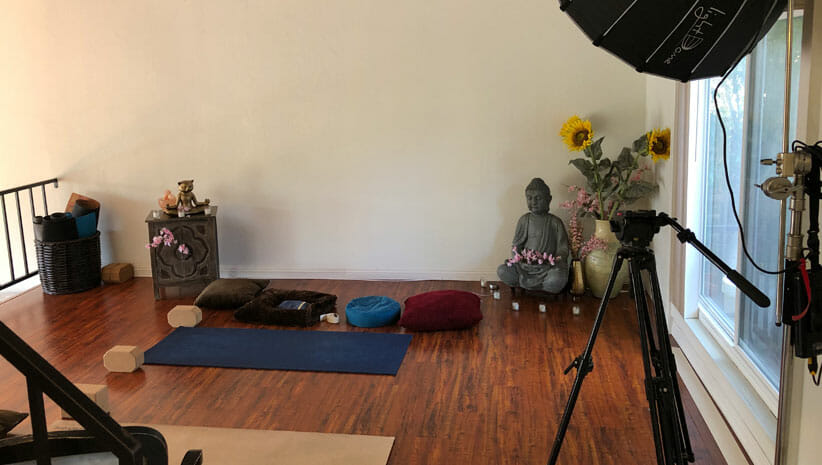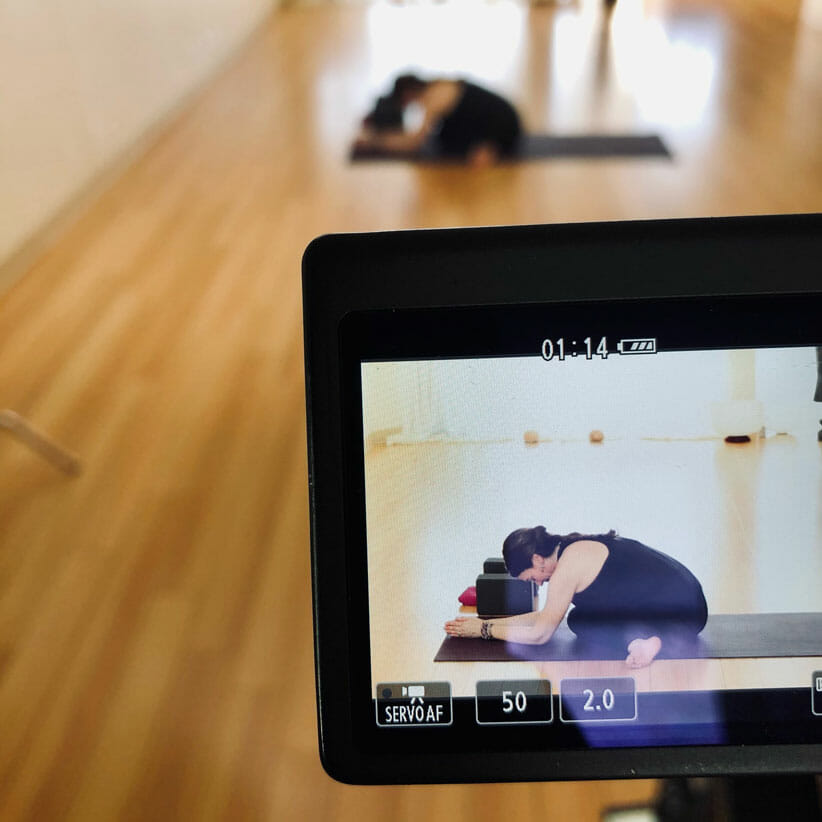
The Business of Online Yoga Classes
In this new frontier of virtual yoga, teachers are finding themselves having to adapt quickly in order to survive. For some, the transition online has been seamless, building on their already established platforms. For others used to the simplicity of showing up to teach a class and then going straight home, the change has been a bit more daunting as many teachers find themselves now faced with business responsibilities once held by the studio. The biggest adjustment may be having to navigate the financial side of leading daily and weekly classes— particularly when it comes to deciding how and if to charge for those classes, a decision that not only affects their students’ pocketbooks but their own livelihood.
Online yoga as a whole is still somewhat new. The original online yoga giants, Glo (then known as YogaGlo) and YogaVibes debuted in 2008 and 2009 respectively, which is also right around when YouTube gained popularity. In that short time, numerous companies have joined the virtual fitness bandwagon, some surpassing the original titans in reach and usership. Livestreaming classes is an even more recent development in the world of online yoga. It was generally done from brick-and-mortar yoga studios, but since the COVID-19 outbreak of 2020, it has become ubiquitous, with instructors streaming directly from their living rooms.
Yoga Teacher as Business Manager & Online Class Financials
Suddenly, many teachers who had no interest or little experience with virtual yoga found themselves scrambling to move their businesses online. And, in addition to deciding how they would share their classes (e.g., Zoom, Facebook Live/IG Live, YouTube, or another platform), they had to figure out how they would charge. Would they adopt a donation-based model? Or ask for a flat rate? Would they charge at all considering that many people had lost their jobs and that, at the time, shelter-in-place restrictions were only supposed to last a few weeks? And if they did, how would they go about collecting payments?
I recently had the pleasure of speaking with a number of teachers to discuss the various ways they are navigating the financial side of their online businesses. Though they are each doing things uniquely, one common thread ran through every interview: Each teacher has had to continually adapt, and it is in their willingness to do so that they are able to survive.

Filming Yoga Courtesy of Leslie Fightmaster
Earning Through YouTube
Lesley Fightmaster is no stranger to teaching yoga online. Starting her YouTube channel in 2012, Fightmaster now has over 590,000 followers. While YouTube is free for viewers, creators can earn money in a few different ways. Most popular is running ads on your channel or before your videos. Keep in mind that the payout is extremely small, with Fightmaster estimating the amount to be one-third of a cent per view. Some creators work with specific advertisers in hopes of boosting revenue, and Fightmaster had some success doing this in the past, but she prefers to work with brands she really uses and loves and that can be limiting.
In the past, Fightmaster also attempted a donation-based approach through asking for contributions after her YouTube classes, but it was not financially feasible for her family of two boys (versus earning through advertising), nor did she feel comfortable asking. Since throughout the pandemic, she has been leading a free weekly class, followed by a Q&A.
Pros: Wide audience reach.
Cons: May take a long time to earn a living, if this is he only source of income.
Free to Access
Sean Haleen has been traveling the United States teaching for well over a decade. He currently leads multiple group classes and private sessions weekly on Zoom and serendipitously joined YouTube just before the pandemic. Haleen shares his classes in a manner that he calls “free to access” in response to how many students were financially hit by the coronavirus. Though he offers his classes for free, through his existing communications with students and the “about” section on his YouTube channel, he does mention that donations for online yoga classes are optional. In lieu of money, he asks people to consider subscribing to his page and/or sharing his teaching schedule with others, explaining that those actions are also “a form of compensation and actually lead to quite a few new students.” Haleen notes that offering classes for free or lowering prices for those unable to afford yoga may not be the right model for everyone, as many teachers themselves can be low-income earners. However, he feels that the teachers doing well financially “have more of an imperative to create accessible content because it affects their livelihoods less.”
Pros: Being of service.
Cons: Only possible with other sources of income.
Donation-Based Classes
Veteran teacher Whitney Allen has been leading in-person yoga classes since 2003, but joined the online yoga world more recently with filmed classes on Wanderlust (now Commune) in 2016. During the pandemic, Allen has mostly been teaching through Instagram Live, as that is where she already had the most contact with her students. So the transition felt simple, although she also teaches classes on Zoom.
As she considers her teaching as being of service, she prefers offering her classes in free-to-use formats, but she also acknowledges that she relies on donations for income, gratefully accepting any contributions. While the system is currently working for her, she notes that people seem to be donating less than at the beginning of the pandemic, which can be scary. Still, Allen does not “police people” about paying and encourages them to take class even if finances are tight and they aren’t able to donate much.
Hillary Skibell, a life coach and yoga teacher based in Marin County, California, chose a donation-based approach both to make her classes financially accessible, and because it felt uncomplicated at a time of much uncertainty. She and her students had to switch to this new livestream format almost “overnight,” and collecting donations through Venmo allowed her to dive right in.
At first, Skibell saw the donation-based model as a short-term experiment, but now that it is clear that virtual classes will be a part of her long-term business plan, she will likely be moving to a set rate. Still, Skibell considers her time using the donation model successful, sharing that there were many days she earned more than if her classes were a fixed cost.
Pros: Makes classes accessible to people of all means.
Cons: Unreliable source of income. Can feel like an uneven exchange.

Home Yoga Studio Photo by Joan Hyman
Pay-Per-Class Honor System
Others are successfully charging for classes based on “an honor system,” as Los Angeles-based teacher trainer Tiffany Russo calls it. This is where teachers say their class costs a specific amount, but still give free access to their teaching content, leaving it up to the student to follow through and pay. Russo made the shift from donation-based yoga to the honor system three months into quarantine when she realized that virtual teaching was here to stay.
While it is not “foolproof,” Russo finds the energy exchange “cleaner.” When she charges a flat rate, she feels properly compensated for the amount of energy she puts into preparing and leading her online yoga classes, versus with the donation model, where many students do not pay anything or pay very little. Another motivation for her to make the move to a clear price was that the donation model didn’t feel financially sustainable. That said, it was very important to Russo to set a price that is affordable for her students, while still charging enough to make ends meet.
YogaWorks teacher Jocelyn Solomon is also using the honor system approach. Solomon never even considered the donation model, musing that it “disempowers teachers by leaving the discernment to place value on their teaching to an outside source.” Like Russo, she prefers the clarity of charging a set amount. Solomon actually started with Zoom’s webinar feature, which included a paywall that students needed to pass through before receiving the link to her class. She switched to Zoom’s meeting option and is now using the honor system because she wanted more interaction with her students.
To ensure students pay for online yoga classes, Solomon has clear languag on her website but is also very open to making exceptions, just as she did pre-coronavirus—like when “guesting” someone in a class, which is when a teacher can have someone take their class at a studio for free.
Pros: Clear energy exchange.
Cons: Not everyone pays.
Paywalls for Online Yoga Classes
For internationally recognized yoga teacher Joan Hyman, going online has had some great benefits. Prior to the pandemic she was getting on a plane every week, whereas now she has access to her students from all around the world in one place. Part of Hyman’s success was her ability to adapt quickly. In the very beginning, she taught a free weekly class through YouTube and a “pay-what-you-can” class on Zoom, but the moment she sensed lockdown extending and saw travel bans being put in place, she moved all of her offerings online, leading the pack by offering big-ticket items virtually, including workshops and retreats.
As her virtual offerings expanded, Hyman decided to invest in paywall software (versus individually collecting payments through a platform like Venmo), which is a way for you to restrict access to online content unless paid. Hyman discusses why she made the move, saying, “It’s hard to be a business manager and keep track of everyone’s classes. It takes a lot of work to keep up the accounting. Acuity has helped me organize all payments, keep track of students’ classes, and send links to students to join.” Some teachers also find using paywalls more professional than Venmo and PayPal.
Another popular paywall software that teachers are using is Momoyoga. It is important to keep in mind that there are monthly fees for any of these services, so unless you’re teaching multiple classes or have other offerings, such as classes for purchase or workshops and trainings, it may not make financial sense. There is also the aspect of having to learn a new technology and transitioning your current system over to a new one. Hyman suggests getting help setting these up if needed, offering the advice, “Stick to what you know and pay someone for their skills to help your business grow.”
Pros: No uncomfortable money exchanges with students. Professional interface.
Cons: Having to learn a new technology. The cost of running the software.
A Whole New World
As I write this, we are now six months into this quarantine virtual-yoga existence, and though gyms and studios are slowly reopening, it is clear that many of the teachers who moved online are here to stay. And as they get more comfortable, many are shifting how they first offered and charged for classes and still may continue to do so. See, that’s the cool thing about this new virtual yoga world: It’s unchartered territory and, therefore, we can create whatever we would like. Anything is possible! Now if we can only figure out how to give virtual savasana adjustments.
Sarah Ezrin is the author of The Yoga of Parenting: Ten Yoga-Based Practices to Help You Stay Grounded, Connect with Your Kids, and Be Kind to Yourself. She is a freelance writer, yoga educator, and content creator based in the Bay Area. Her willingness to be unabashedly honest and vulnerable along with her innate wisdom, make her writing, teaching, and social media great sources of healing and connection for many people.
Sarah brings a wide spectrum of life experiences into everything she does. She is unafraid of sharing all sides of herself. She does so in the hope of giving others permission to be their most authentic self. At this time, when honest self-awareness is so important, Sarah’s is an essential and exemplary voice.
Sarah writes extensively on the subjects of yoga, parenting, and mental health, often interweaving these themes. Her work ranges from heavily-reported assignments to personal essays to blog content for brands. She is a regular contributor for Yoga Journal Magazine, Motherly, Yoga International, Healthline, Scary Mommy, Mind Body Green, Mantra Magazine, and LA Yoga Magazine. She has been featured in the Wall Street Journal, Forbes Magazine, Bustle, LA Weekly, and NBC News.
Sarah is a well-respected yoga teacher and a leader in the wellness community. A world traveler since birth, she has led trainings, workshops, and retreats locally and across the globe.
